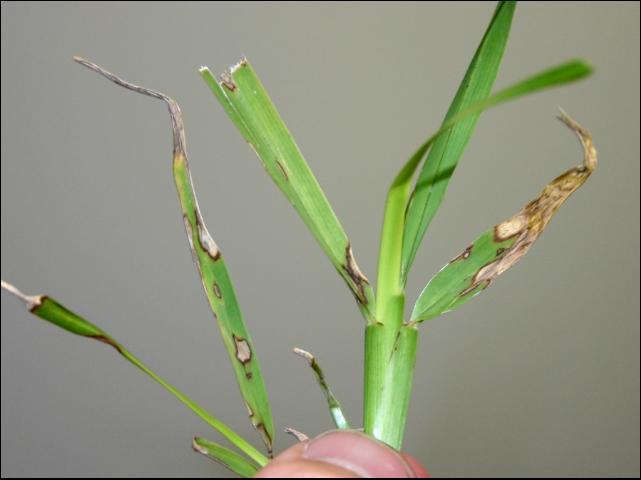
by Larry Williams | Jul 22, 2013
Gray Leaf Spot is a common fungal disease of St. Augustinegrass. Recent wet conditions have promoted this disease. This includes high humidity, heavy dews and particularly frequent afternoon and evening rains.
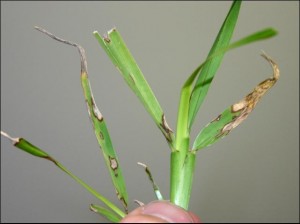
Gray leaf spot symptoms on St. Augustinegrass. Photo credit: UF/IFAS Extension
The individual spots or lesions are first seen as tiny brownish spots smaller than a pinhead. As they become larger, they will be circular and then begin to elongate lengthwise along the leaf. The spots will become brown to grayish in appearance. Numerous spots or lesions may be found on an individual leaf. Heavily infected leaves begin to turn brown and wither, usually beginning at the tip of the blade.
Gray leaf spot can move rapidly during prolonged warm, wet periods. Over watering or irrigating in the evening provides the prolonged period of wetness required for disease infection. For more information on how to correctly water a Florida lawn, visit the UF / IFAS Lawn Watering Website.
According to the Florida Lawn Handbook, “Severity of the disease is enhanced by application of readily available nitrogen fertilizer and is proportional to the amount of nitrogen applied.” Select fertilizers that are low in nitrogen or that have slow release nitrogen. Be careful to not overdo it in fertilizing your lawn and do not apply a high nitrogen fertilizer on top of an already infected lawn. Also, some lawn weed killers such as atrazine will increase the susceptibility of the grass to gray leaf spot.
Irrigate during early morning hours to minimize the period in which the grass is wet and water only on an as needed basis, watering less often but deeply. Avoid frequent, shallow watering and don’t irrigate when the lawn is already wet from rain. With the recent frequent rains, very little to no supplemental irrigation has been needed on most lawns in our area. Avoid leaving irrigation timers on when adequate rainfall has occurred. It’s best to operate irrigation controllers on manual so that the lawn can be monitored and irrigation provided during dry times.
If the disease outbreak is severe, fungicide may be needed. Look for products containing propiconazole, triadimefon or thiophanate-methyl. Always follow the product’s label directions and precautions.
For more information on maintaining a Florida lawn, contact your County UF/IFAS Extension Office or visit the YourFloridaLawn Website.
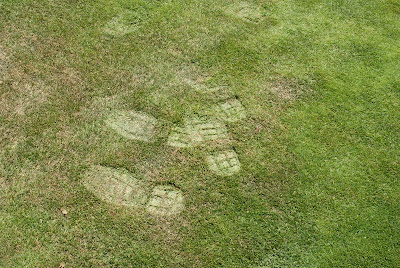
by Taylor Vandiver | Jul 15, 2013
Turfgrass, like all plants, requires water for growth and survival. With the weather we’ve been having lately, watering your lawn is probably the last thing on your mind.
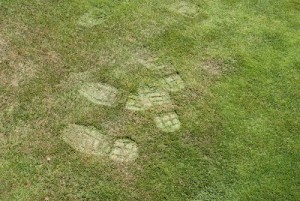
Footprints in turfgrass are a common symptom of drought stress. They are the result of a loss in turgor pressure, due to lack of water, in plant tissue.
However, without sufficient rainfall, water to home lawns will need to be supplemented with irrigation. The most efficient way to irrigate or water your lawn is to apply water only when the lawn starts to show signs of drought stress from lack of moisture.
A few signs associated with drought stress include the changing of turfgrass color from green to a bluish-gray, or white cast. Another sign could be “footprints” on the lawn. If walking across a lawn late in the afternoon causes footprints to be left behind, the lawn may need watering. When feet compress the leaf blades of the turfgrass, the low water levels in the plant tissue prevent the leaf blades from recovering, or “springing” back up, after being pushed down. If the footprints remain for an extended period of time, water the lawn to prevent the turfgrass from turning brown and becoming dormant. The visual condition of the turfgrass can also be used to evaluate drought stress. Turfgrass blades respond to drought stress by folding, rolling, and/or wilting.
A recommended application of ½ to ¾ inch of water can be applied when your turfgrass begins to show the drought stress symptoms discussed previously. Once this amount of water is applied, do not apply again until drought is noticeable. If it rains, like it has been lately, hold off on irrigating until visible drought stress symptoms appear.
Irrigation frequency can vary based on grass species, rainfall amounts, soil type and amount of compaction, shade presence, location, etc. There is a fine line between under and over watering a lawn. Over watering can cause problems such as poor root growth and susceptibility to disease. Over watering can also increase the presence of weed species. When watering, avoid applying water to the point of runoff. Allow the water to soak into the lawn and soil. The optimal time of day to water lawn grass is during the early morning hours. If irrigation is done during the day that water is being lost to higher evaporation rates. Watering in late afternoon or late morning may be detrimental if it extends the time the lawn is naturally wet from dew. This extended “dew period” may increase disease presence in turf.
Automated irrigation systems are convenient, but can have flaws. Always check to make sure your system is working properly and is applying the correct amount of water. However, if significant rainfall has fallen for the week, the automated timed irrigation systems can be turned off so water is not wasted.
Once turf has been watered, it should not be watered again until similar drought stress symptoms are observed. It is never suggested to water your lawn every day, unless it is in the establishment phase or renovations are occuring. Proper watering techniques are key to creating a happy and healthy lawn.
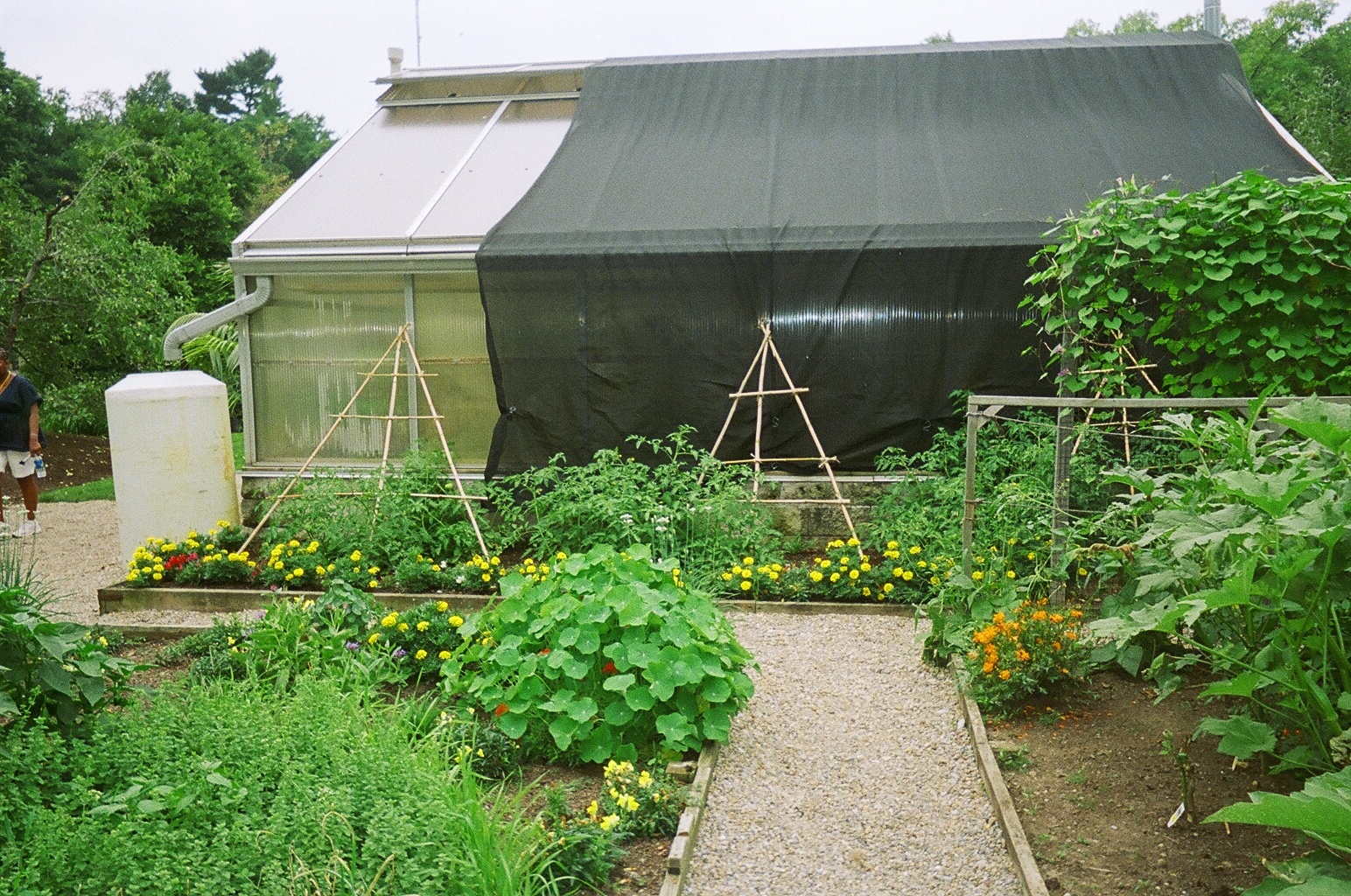
by Eddie Powell | Jul 15, 2013
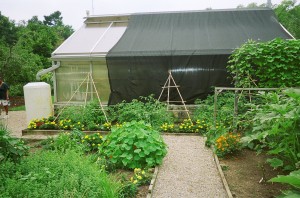
Image Credit: Eddie Powell
Before the new school year begins for the kids in your county, consider volunteering at your local school garden.
The following information has been adapted from the UF IFAS Florida school garden competition website article “Benefits of School Gardens”
School gardens offer benefits to volunteers and students that go beyond the classroom. They provide a platform for students, teachers, and members of the community to interact in an outdoor learning environment. This type of interaction creates opportunities for students to improve social skills and practice collaborative learning.
It is essential that school gardens are given proper care and maintenance. Giving students the responsibility to water and care for the plants instills in them a sense of accountability. Patience is another virtue that students practice through garden participation, as plants do not grow, flower, or fruit overnight.
As the garden grows and becomes fruitful, students will take pride in the efforts that they put forth. This pride can help bolster self-esteem and allow students to invest in the beautification of their school. In this age of urbanization, children’s contact with nature is limited. Thus, school gardens ensure student contact with the environment.
School gardens allow students to work in a non-threatening outdoor environment where they can interact and learn about nature. Studies have shown that students who are allowed to learn in an outdoor environment, such as a garden, have improved environmental attitudes.
School gardens are a wonderful and exciting way to make school subjects more interesting and meaningful. School gardens create a learning structure that allows for creative thought, active learning, and social skills. The garden is a living lab that can serve as an excellent resource to teach various subjects, while allowing students to learn in an environment that is atypical to the sterile classrooms to which most students are accustomed.
Teachers throughout the country are discovering how useful and educational gardening can be. School gardens should be used to teach practically every subject covered in an elementary school classroom. The garden is a perfect place for students to learn about plants, insects, weather, and many other science and math-related topics.
For more information on helping a local school garden programs, contact your county University of Florida / IFAS Extension Office, which should have a list of the schools in your area that are teaching gardening. Also remember to ask about the Farm to School Program, which has resources for school gardens.
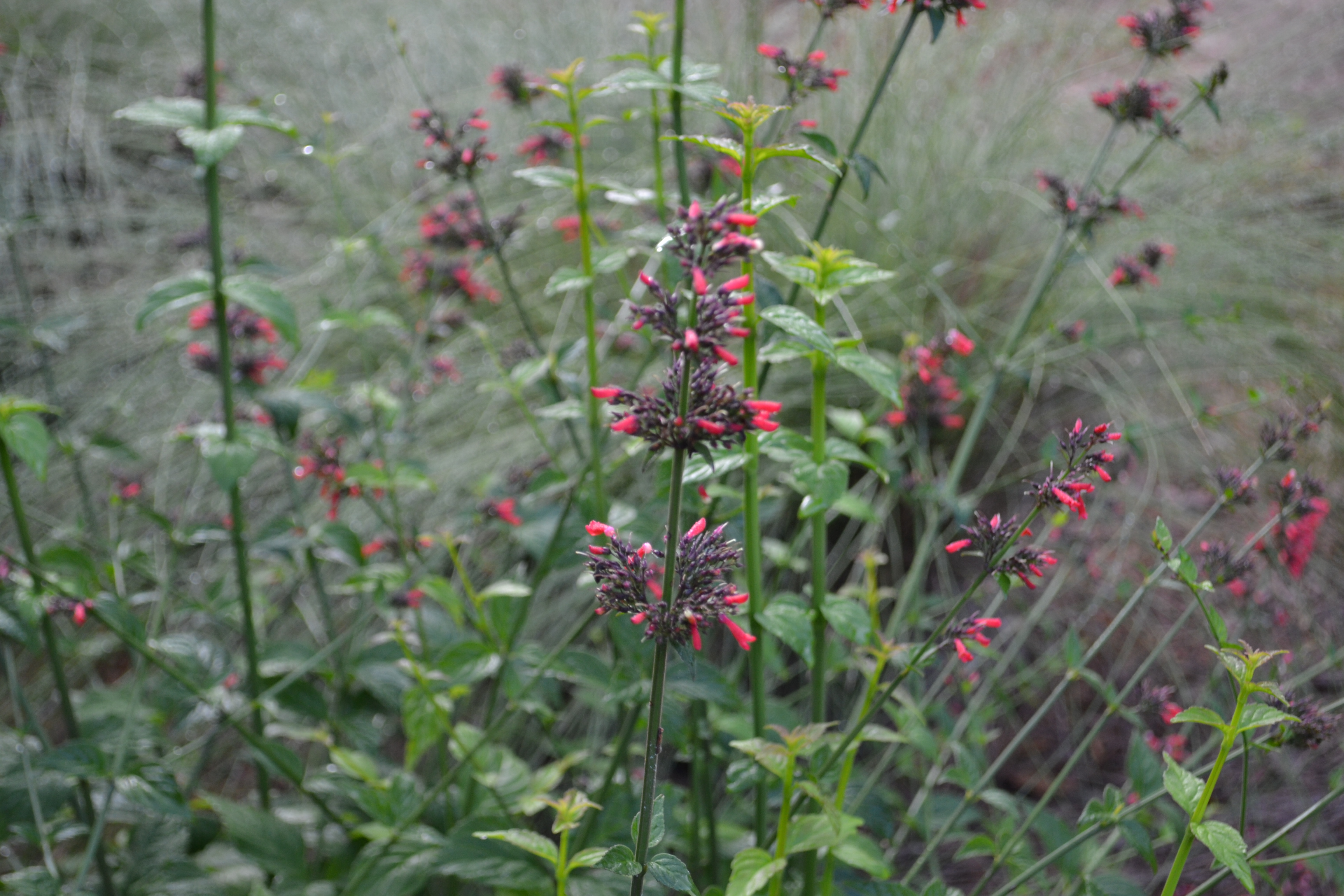
by Beth Bolles | Jul 7, 2013
Bring your own blend of fireworks to the garden this July by adding the Red Rocket Russelia, Russelia sarmentosa to a full sun area.
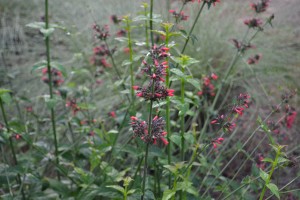
- Russelia sarmentosa. Image Credit Beth Bolles, University of Florida
A favorite perennial to those who grow it, the Red Rocket has many positive qualities that make it a must have for everyone. Plants form a large group of arching stems that grow 5-6 feet in height. Clusters of tubular red flower occur at each node, covering the entire stem in color. Flowering occurs soon after regrowth from winter cold and continues until the first frost. Once established plants perform well with occasional irrigation or a routine rain shower. The added bonus of this colorful perennial is that hummingbirds visit flowers often to feed on nectar.

by Carrie Stevenson | Jul 7, 2013
Floridians use more water than any other state for irrigation, and a typical home sprinkler system can account for half of the cost and water use in a household during the summer.
One of the most convenient and efficient ways to conserve water is to install a rain barrel. Modern rain barrels involve ancient technology that relies simply on gravity, allowing stormwater to run from a rooftop into a gutter. The gutter funnels water into a plastic food-grade barrel or other container fitted with screen to keep out debris and insects. Most rain barrels also have an overflow device near the top (for heavy storms that might fill the barrel) and a spigot at the bottom for filling a watering can or attaching a hose. Keep in mind the barrels do not have a lot of pressure and cannot irrigate an entire lawn, but are ideal for vegetable gardens and container plants. Rain barrels vary widely in design, but they can be painted to add a decorative touch, or easily screened behind a shrub.
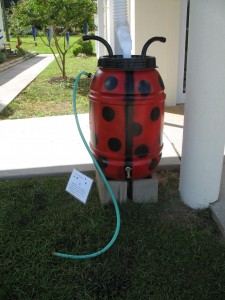
Building a rain barrel is a fun summer project for the whole family!
In addition to conserving water, rain barrels can be an effective means of reducing stormwater pollution. During a typical 1” rainstorm, an average home’s roof can yield 600 gallons of rainwater runoff that would normally flow downstream, picking up oils, greases, bacteria, trash, and pesticides along the way that end up in our water bodies. These pollutants eventually flow downstream to our creeks, bayous, and bays, contributing to non-point source pollution. Rain barrels interrupt that process by collecting stormwater runoff before it has a chance to pick up pollutants.
If you are interested in learning more about rain barrels or how to build your own, contact your local County Extension Office. Escambia County Extension will be hosting two rain barrel workshops this summer, the first on Friday, July 12 and the second on Saturday, August 3. There is a $42 charge for those wishing to build their own rain barrel after the workshop—all supplies and tools will be provided. To register for the full workshop, go online to the event registration website.
It is free to attend and hear the talk without building a barrel, but please reserve a spot by using the contact information below.

by Eddie Powell | Jul 1, 2013
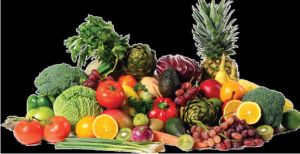
The key to eating home grown delicious vegetables, is selecting the correct time to harvest. Below are some of the easiest ways to identify the correct time to pick your most common summer veggies.

- Snap Beans: Pick them before you can see the seeds bulging. They should snap easily into two. Check daily. It doesn’t take long for beans to go from tender to tough.
- Corn: Usually 3 weeks after the silks form, they will turn dry and brown. The kernels should exude a milky substance when pricked.
- Cucumber: Cucumbers race to the harvest with zucchini. Check daily and harvest young. Timing and length will vary with variety. The fruits should be firm and smooth. Overripe cucumbers can be very bitter or pithy, even before they start to turn yellow.
- Eggplant: Slightly immature fruits taste best. The fruits should be firm and shiny. Cut rather than pull from the plant.
- Muskmelon (cantaloupes): The general rule of thumb is that the color should change to beige and the fruit will ‘slip’ from the vine when lifted. You should also be able to notice a sweet smell when ripe.
- Peas: The pea pods should look and feel full. Peas are sweeter if harvested before fully plumped. Peas really need to be tasted to determine if they are sweet enough.
- Pumpkins: Once the pumpkins have turned the expected color and the vines are starting to decline, check to make sure the skin has hardened enough that poking it with your fingernail will not crack it. You don’t want to pick your pumpkin too soon, because it will stop turning orange once its cut, but don’t leave them out if a hard frost is expected.
- Squash: Pick young and check often. The skins should be tender enough to poke your fingernail through.
- Tomatoes: Harvest tomatoes when they are fully colored and slightly soft to the touch. Gently twist and pull from the vine.
- Watermelon: The white spot on the bottom of the melon should change to a deep yellow when ripe. Some people can hear a change in the sound made when the melon is thumped with the finger. It should make a hollow sound when ripe, but this is a skill that must be developed.
For more information about projected harvest times, check out the Florida Vegetable Production Guide, published by UF / IFAS Extension. Enjoy and share your garden’s bounty, happy harvesting.













